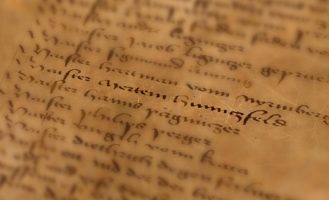Martin Hundsfeld In literature and sources also known as Martin Huntsfeld, Martein Hundtfeltz, Martein Huntfeltz, or Martein Hündsfelder.—fencing master presumably from the first half of the 15th century. He was listed by Paulus Kal as one of the members of the Society of Liechtenauer A group to which P. Kal attributes seventeen fencing masters that are said to have studied under the very J. Lichtenauer: Peter Wildigans von Glatz, Peter von Danzig zum Ingolstadt, Hans Spindler von Znaim, Lamprecht von Prague, Hans Seydenfaden von Erfurt, brothers Andres and Jacob Lignitzer, Sigmund ain Ringeck, Hartman von Nuremberg, Martin Huntfeltz, Hans Pegnitzer, Philipp Perger, Virgil of Kraków, Dietrich Degenfechter von Braunschweig, Ott Żyd, Hans Stettner von Mörnsheim, and Paulus Kal. Paulus Kal Fechtbuch, folio 2v, https://wiktenauer.com/wiki/Paulus_Kal_Fechtbuch_(Cgm_1507)#/media/File:Cgm_1507_02r.jpg, [DOA 26.07.2021]. The manuscript is stored at the Bavarian State Library in Munich (cat. no. Cgm 1507).. M. Hundsfeld’s period of life is defined based on the phrase “may God have mercy on him” appearing in Starhemberg Fechtbuch from 1452 Starhemberg Fechtbuch, folio 87r (Cod.44.A.8). The treatise is also known as Codex Danzing. Wiktenauer, a HEMA Alliance Project, Starhemberg Fechtbuch (Cod.44.A.8), https://wiktenauer.com/wiki/Starhemberg_Fechtbuch_(Cod.44.A.8) [DOA 25.07.2021]. The manuscript is located at the Biblioteca dell’Accademia Nazionale dei Lincei e Corsiniana in Rome (cat. no. MS 1449)., which clearly indicates that at the time of the creation of the said treatise, the master was no longer alive.
There are two theories regarding M. Hundsfeld’s descent. The first one, which is less probable, refers to his last name. It connects the master’s place of birth with the region of today’s Wrocław. According to the chronicles of Gallus Anonymus and Wincenty Kadłubek, it is here where in 1109 the armies of the Duke Bolesław III Wrymouth and the King of Germany Henry V fought G. Anonymus only mentions that such a battle took place in the following fragment: “the caesar approached the town of Wrocław, where he gained nothing more but the dead in place of the living.” Anonim tzw. Gall, Kronika Polska, Wydawnictwo Zakład Narodowy im. Ossolińskich, Wrocław – Warszawa – Kraków 2008, p. 140. W. Kadłubek, on the other hand, describes it in more detail and defines it as a great victory of the Polish army. He writes: “As a proof of this, there is also the name of this place, where a big pack of dogs, devouring enormous number of corpses, became so ferocious that no one was brave enough to pass the place, and thus it gained its name “Psie Pole”. See Kadłubek W., Kronika Polska, Wydawnictwo Zakład Narodowy im. Ossolińskich in cooperation with De Agostini Polska Sp. z o.o., Wrocław 2003, p. 136-138.. After the battle, a big pack of dogs tearing apart the corpses is said to have appeared, hence the name “Psie Pole” (German: Hundsfeld; English: Dog’s Field). Historians, however, argue whether such a battle ever took place See, e.g. S. Orgelbrand (ed.), Encyklopedia Powszechna T.3, Wydawnictwo Orgelbranda, Warszawa 1865, p. 728 and J. Harasimowicz (ed.), Encyklopedia Wrocławia, Wydawnictwo Dolnośląskie, Wrocław 2006, p. 731-732.. The second theory holds that the master came from the village Hundsfeld located around 20 km East of Würzburg in Bavaria.
M. Hundsfeld concentrated primarily on armoured fighting (Harnischfechten) with sword in a half-sword grip, wrestling techniques (the so-called grappling), as well as dagger and mounted fighting (Rossfechten) In the German fencing tradition, the so-called half-sword techniques are referred to in the sources as the “short-sword” techniques. What is to be understood through this is the “shortened sword”, i.e. the way of holding a sword in the middle of the blade during combat with an armoured opponent. Both M. Hundsfeld and A. Lignitzer indicate this in the first verses of their treatises on this combat method. See. e.g. M. Maziarz, B. Walczak, G. Żabiński (transl. and eds.), Peter von Danzing. Średniowieczne Sztuki Walki według XV-wiecznego traktatu szermierczego, Wydawnictwo: Napoleon V, Warszawa-Oświęcim 2016, p. 225, 273.. The teachings of the master are available in: (1) the compilation Starhemberg FechtbuchStarhemberg Fechtbuch, folios 87r-100r, op. cit., in which short-sword techniques, wrestling in armour, as well as dagger and mounted fighting techniques are described; (2) Codex Lew Codex Lew, folios 54-70, https://wiktenauer.com/wiki/Codex_Lew_(Cod.I.6.4º.3) [DOA 28.07.2021]. The manuscript is located at the University Library in Augsburg (cat. no. I.6.4º.3)., in which, as a result of a mistake, short-sword techniques belonging to M. Hundsfeld, were incorrectly assigned to Jud Lew, and those belonging to Andre Lignitzer were assigned to M. Hundsfeld D. Jaquet, B. Walczak, Liegnitzer, Hundsfeld or Lew? The question of authorship of popular Medieval fighting teachings, “Acta Periodica Duellatorum” 2014, no. 1(2), p. 105-148.; and (3) another compilation Allerley Kampf zur Roß und Fueß in und an Harnisch (“All Manner of Combat on Horse and on Foot, Both Armored and Unarmored”) Allerley Kampf zur Roß und Fueß in und an Harnisch, folios 124-127, https://wiktenauer.com/wiki/Paulus_Kal_Fechtbuch_(MS_KK5126) [accessed on 28.07.2021]. The manuscript is located at the Museum of Art History in Vienna (cat. no. MS KK5126). by Paulus Kal, which holds the teachings of M. Hundsfeld on grappling, short- sword fencing and mounted combat.
Master M. Hundsfeld was an interesting and mysterious person. Basically nothing is known about his life. Studying his teachings reproduced in other treatises, one can assume that he was an experienced warrior, who deserved his place among the other masters of the Society of Lichtenauer.

